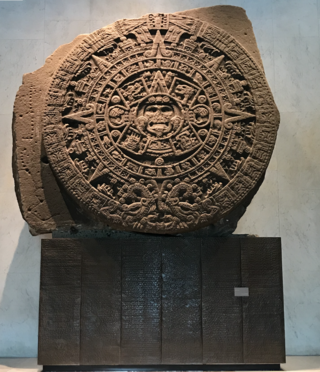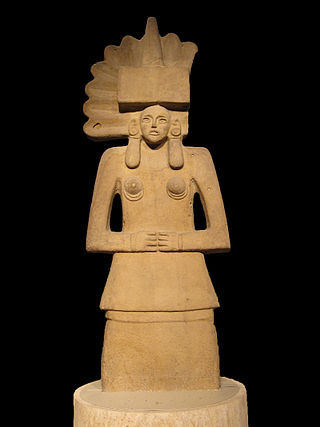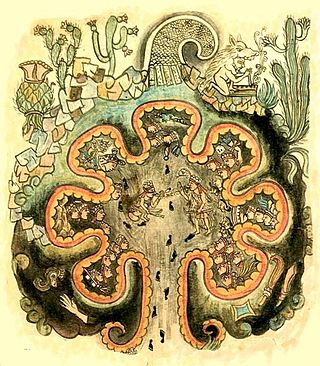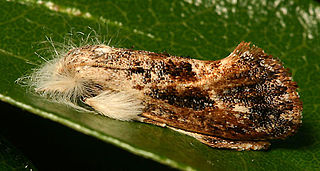
Motecuhzoma Xocoyotzin, variant spellings include Moctezuma, Motewksomah, Motecuhzomatzin, Montezuma, Moteuczoma, Motecuhzoma, Motēuczōmah, Muteczuma, and referred to retroactively in European sources as Moctezuma II, was the ninth Emperor of the Aztec Empire, reigning from 1502 or 1503 to 1520. Through his marriage with Queen Tlapalizquixochtzin of Ecatepec, one of his two wives, he was also king consort of that altepetl.

The Aztecs were a Mesoamerican culture that flourished in central Mexico in the post-classic period from 1300 to 1521. The Aztec people included different ethnic groups of central Mexico, particularly those groups who spoke the Nahuatl language and who dominated large parts of Mesoamerica from the 14th to the 16th centuries. Aztec culture was organized into city-states (altepetl), some of which joined to form alliances, political confederations, or empires. The Aztec Empire was a confederation of three city-states established in 1427: Tenochtitlan, city-state of the Mexica or Tenochca, Texcoco, and Tlacopan, previously part of the Tepanec empire, whose dominant power was Azcapotzalco. Although the term Aztecs is often narrowly restricted to the Mexica of Tenochtitlan, it is also broadly used to refer to Nahua polities or peoples of central Mexico in the prehispanic era, as well as the Spanish colonial era (1521–1821). The definitions of Aztec and Aztecs have long been the topic of scholarly discussion ever since German scientist Alexander von Humboldt established its common usage in the early 19th century.

The Aztec or Mexica calendar is the calendrical system used by the Aztecs as well as other Pre-Columbian peoples of central Mexico. It is one of the Mesoamerican calendars, sharing the basic structure of calendars from throughout the region.

The Aztec Empire or the Triple Alliance was an alliance of three Nahua city-states: Mexico-Tenochtitlan, Tetzcoco, and Tlacopan. These three city-states ruled that area in and around the Valley of Mexico from 1428 until the combined forces of the Spanish conquistadores and their native allies who ruled under Hernán Cortés defeated them in 1521.

Toci is a deity figuring prominently in the religion and mythology of the pre-Columbian Aztec civilization of Mesoamerica. In Aztec mythology, she is seen as an aspect of the mother goddess Coatlicue or Xochitlicue and is thus labeled “mother of the gods”. She is also called Tlalli Iyollo.
The Mexica Movement is an "Indigenous rights educational organization" based in Los Angeles, California. Their organization views Mexicans of Native Mexican and Amerindian descent, as one people who are falsely divided by European-imposed borders. Their ultimate objective is the non-violent, democratic "liberation" of the Western Hemisphere from European-descendants. The organization seeks to create a future nation called Cemanahuac. The group views "White" people as Europeans who are squatting on indigenous lands, and who must be repatriated back to Europe. The group rejects the "Aztlán ideology" as being too limited, seeking instead to unite the entire American continents under indigenous control.

Slavery in the Aztec Empire and surrounding Mexica societies was widespread, with slaves known by the Nahuatl word, tlacotli. Slaves did not inherit their status; people were enslaved as a form of punishment, after capturing in war, or voluntarily to pay off debts. Within Mexica society, slaves constituted an important class.

The Aztecs were a Pre-Columbian Mesoamerican people of central Mexico in the 14th, 15th, and 16th centuries. They called themselves Mēxihcah.

Chicomoztoc is the name for the mythical origin place of the Aztec Mexicas, Tepanecs, Acolhuas, and other Nahuatl-speaking peoples of the central Mexico region of Mesoamerica, in the Postclassic period.

Acrolophinae is a family of moths in the order Lepidoptera. The subfamily comprises the burrowing webworm moths and tube moths and holds about 300 species in five genera, which occur in the wild only in the New World. It is closely related to the Tineidae family.

Maya Revival is a modern architectural style popular in the Americas during the 1920s and 1930s that drew inspiration from the architecture and iconography of pre-Columbian Mesoamerican cultures.

The Mexica were a Nahuatl-speaking people of the Valley of Mexico who were the rulers of the Mexica Empire. The Mexica established Tenochtitlan, a settlement on an island in Lake Texcoco, in 1325. A dissident group in Tenochtitlan separated and founded the settlement of Tlatelolco with its own dynastic lineage. In 1521, they were conquered by an alliance of Spanish conquistadors and indigenous people including the Tlaxcaltecs led by Hernán Cortés.
Cuāuhtlahtoāni or Cuäuhtlahtoh is a titular office of governorship and political administration, used within certain city-states and provinces among the Aztecs of pre-Columbian central Mexico in the Late Postclassic period. The office of cuauhtlatoani carried the connotation of "military ruler" or "appointed administrator". During the rise of the Aztec Empire the title was given by the ruling Mexica-Tenochca to the governors they imposed on conquered city-states in central provinces.
Poder Mexica is a professional wrestling stable currently working for Consejo Mundial de Lucha Libre (CMLL). The stable was founded in December 2008 and consists of Sangre Azteca and Misterioso, Jr. Black Warrior and Dragón Rojo, Jr. were originally members of the group, but left in the fall of 2009 and 2010 respectively.
Sangre Azteca is a Mexican luchador enmascarado, or masked professional wrestler is primarily known for his work for Consejo Mundial de Lucha Libre (CMLL). Sangre Azteca's real name is not revealed in public, as is often the case with masked wrestlers in Mexico where their private lives are kept a secret from the wrestling fans. He is part of the rudo stable "Poder Mexica" along with Dragon Rojo Jr. and Misterioso Jr.
Misterioso Jr. is a Mexican luchador enmascarado, or masked professional wrestler, who is also referred to as Misterioso II. Misterioso Jr. is the nephew of Misterioso who wore a similar mask until losing it in 1997. Misterioso Jr. has mainly worked for the Mexican professional wrestling promotion Consejo Mundial de Lucha Libre (CMLL) throughout his career, where he won the 2006 Gran Alternativa tournament with Perro Aguayo Jr. Over the summer of 2009, Misterioso Jr. joined the wrestling group Poder Mexica.

The Liga de Fútbol Americano Profesional, commonly known simply as LFA, is a professional American football league in Mexico, founded in 2016. Starting with four teams, the LFA has since expanded to eleven members as of 2022. The regular season runs in the spring, from early March to late April. The championship game is called Tazón México, and is currently played on the second Sunday in May. The players are drafted from the country's two college football conferences: ONEFA and CONADEIP and through international drafts, which mainly recruit American players.

The Mexicas de la Ciudad de México, also called Mexicas LFA or Mexicas CDMX, are an American football team based in Mexico City (CDMX), Mexico. The team was founded in 2015 with the name of Eagles, and is one of the four charter members of the Liga de Fútbol Americano Profesional, the top American football league in Mexico. The Mexicas play their home games at the Estadio Jesús Martínez "Palillo".













